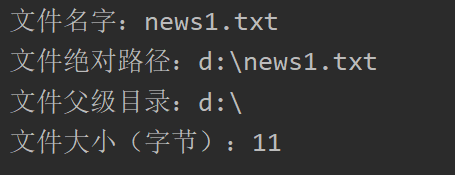IO流之文件
IO流之文件
常用的文件操作:
-
-
new File(File parent,String child) //根据父目录文件+子路径构建
-
new File(String parent,String child) //根据父目录+子路径构建
-
createNewFile 创建新文件
package com.io.file; import org.junit.jupiter.api.Test; import java.io.File; import java.io.IOException; /** * 创建文件 */ public class FileCreate { public static void main(String[] args) { } //法一:new File(String pathname) //根据路径构建一个File对象 @Test public void create01(){ String filePath="d:\\news1.txt"; File file = new File(filePath); try { file.createNewFile(); System.out.println("文件创建成功"); } catch (IOException e) { e.printStackTrace(); } } //法二:new File(File parent,String child) //根据父目录文件+子路径构建 //创建d:\\news2.txt @Test public void create02(){ File parentFile=new File("d:\\"); String fileName="news2.txt"; //这里的file对象,在java程序中,只是一个对象 //只有执行了createNewFile方法,才会真正的在磁盘创建该文件 File file = new File(parentFile, fileName); try { file.createNewFile(); System.out.println("文件创建成功"); } catch (IOException e) { e.printStackTrace(); } } @Test //法三:new File(String parent,String child)//根据父目录+子路径构建 public void create03(){ String parentPath="d:\\"; String fileName="news3.txt"; File file = new File(parentPath, fileName); try { file.createNewFile(); } catch (IOException e) { e.printStackTrace(); } System.out.println("文件创建成功"); } }
获取文件信息:
package com.io.file; import org.junit.jupiter.api.Test; import java.io.File; /** * 获取文件信息 */ public class FileInformation { public static void main(String[] args) { } //获取文件信息 // 方法:getName、getAbsolutePath、getParent、length、exists、isFile、isDirectory @Test public void info(){ //先创建文件对象 File file = new File("d:\\news1.txt"); //调用相应的方法,得到对应的信息 System.out.println("文件名字:"+file.getName()); System.out.println("文件绝对路径:"+file.getAbsolutePath()); System.out.println("文件父级目录:"+file.getParent()); System.out.println("文件大小(字节):"+file.length()); } }
目录的操作和文件删除:
mkdir创建一级目录、mkdirs创建多级目录、delete删除空目录或文件
package com.io.file; import org.junit.jupiter.api.Test; import java.io.File; public class Director { public static void main(String[] args) { } @Test //判断d:\\news1.txt是否存在,如果存在就删除 public void m1(){ String filePath="d:\\news1.txt"; File file = new File(filePath); if (file.exists()){ if (file.delete()){ System.out.println(filePath+"删除成功"); }else { System.out.println(filePath+"删除失败"); } }else{ System.out.println("该文件不存在"); } } @Test //判断D:\\demo02是否存在,如果存在就删除,否则提示不存在 //在java编程中,目录也被当成一种文件 public void m2(){ String filePath="D:\\demo02"; File file = new File(filePath); if (file.exists()){ if (file.delete()){ System.out.println(filePath+"删除成功"); }else { System.out.println(filePath+"删除失败"); } }else{ System.out.println("该目录不存在"); } } @Test //判断D:\\demo\\a\\b\\c目录是否存在,如果存在就提示已经存在,否则创建 public void m3(){ String directoryPath="D:\\demo\\a\\b\\c"; File file = new File(directoryPath); if (file.exists()){ System.out.println(directoryPath+"文件存在"); }else{ if(file.mkdirs()){ System.out.println(directoryPath+"该目录创建成功"); }else { System.out.println(directoryPath+"该目录创建失败"); } } } }








 浙公网安备 33010602011771号
浙公网安备 33010602011771号